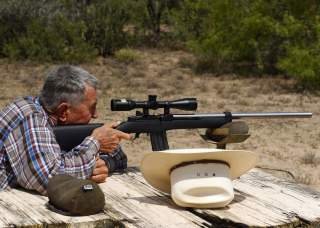Why the Legendary Mini-14 Rifle Was Forgotten
A fascinating weapon.
Key point: This rifle has served in several conflicts.
One of the most enduring and popular semi-automatic rifles in America traces its lineage to the battlefields of World War II and Korea.
The Mini-14 rifle, designed and developed by Sturm Ruger, is in widespread use as a ranch rifle, defensive weapon, and even a hunting arm. Now in its fifth decade, the Mini-14 shows no sign of going out of production anytime soon.
In the late 1960s, firearms designer Bill Ruger and James L. Sullivan went to work on a new semi-automatic rifle design. The new weapon was based on the M14 battle rifle then being phased out of service with the U.S. Army and Marine Corps. The M14 was a short-stroke gas piston, rotating bolt rifle that traced its roots to the World War II M1 Garand rifle. The M14 differed from the Garand primarily in being chambered for the NATO standard 7.62-millimeter cartridge and having a 20 round removable box magazine.
The new weapon was externally similar to the M-14 and would use the same operating system but was rechambered for the .223 cartridge. Just as the M14 in 7.62-millimeter was the M1 Garand scaled down from the .30-06 cartridge, the new weapon was scaled down again to handle the .223 cartridge. The .223 cartridge was nearly identical to the 5.56 cartridge adopted by the U.S. military with the AR15, then M16 and XM177E1 rifles. Ruger had evidently gambled production of .223/5.56 for the Vietnam War would give the cartridge staying power in the States long after the war ended. He was right.
The resulting rifle was smaller and lighter than its military cousin and was introduced for sale by Sturm Ruger Inc. as the Mini-14 in 1973. The Mini-14 weighed 6.39 pounds unloaded, a wooden stock, and iron sights. It weighed just 6.39 ounces empty. It had a practical rate of fire of 40 rounds per minute and could take both 20 and 30 round magazines. Like the M16, the Mini-14 had a right-handed twist rate of 1 in 12 inches, better to stabilize the .223 round in flight. The Mini-14 had an effective range of 200 yards, a distance primarily dictated by the ballistic performance of its ammunition.
The Mini-14 was well received commercially. Aside from a small number of pre-Vietnam AR-15s sold commercially no other rifle did what it did, offering the firepower of a 20 or 30 round magazine. Most semi-automatic rifles at the time were fed from an internal blind magazine. Going to a smaller cartridge also allowed the new weapon to carry up to 30 rounds in a single metal magazine. Although the detachable metal magazines were similar to those used by the M16 they were incompatible. Like the M-14, the Mini-14 had a notch in the magazine that required the user to insert the magazine at an angle and then rotate it upwards into the magazine well.
One side effect of moving to the smaller cartridge: concerns about potentially dangerous chamber pressures when using the 5.56 cartridge. The military-grade 5.56 cartridge, meant above all else to be a man-stopping round, generates considerably higher chamber pressures than the .223 sporting round. The difference in pressure between .223 and 5.56 is theoretically great enough that it is not recommended shooters use 5.56 in an early model Mini-14. Still, there are few if any instances of 5.56 ammunition causing a serious issue, and the problem was eventually worked out by redesigning later versions of the Mini-14 to safely withstand accommodate higher pressures.
Over the years, Sturm Ruger updated the Mini-14 to reflect the latest trends. In 1982, Ruger released the Ranch Rifle, which included mounting points for the installation of scopes. In 1987, as cheap AK-47 ammunition (7.62x39) began flowing in from overseas, Ruger released the Mini-30. The Mini-30 not only gave Americans an inexpensive rifle to shoot even more inexpensive foreign surplus ammunition, it was also technically a .30 caliber, in some states the minimum legal caliber for hunting deer.
The Mini-14 saw service in police SWAT and prison units in the United States. The Mini-14 never saw U.S. military service, although Bill Ruger reportedly believed it could have become the U.S. military’s service rifle instead of the M16 had the timing been right. This would likely have been the select-fire version of the Mini-14, the AC-556. The Mini-14 was adopted by a small number of overseas paramilitary units, including police forces in Northern Ireland and the Bermuda Regiment on the island and Bermuda.
In recent years Ruger has made further changes. The weapon is now available in 6.8 caliber and .300 Blackout, as well as tactical models that incorporate a Picatinny rail for the addition of lights, lasers, and optics. A longer, thicker barrel allows the weapon to be fired for longer periods without losing accuracy. The Mini-14 is particularly favored in states with so-called assault weapons bans, which ban semi-automatic rifles with pistol grips and detachable magazines. Although the Mini-14 has detachable magazines it has a more traditional rifle grip.
The Mini-14 is not as accurate as nor has it attracted as many followers as the AR-15. Still, it is a viable alternative for those looking for a semi-automatic, magazine-fed rifle, especially considering recent gun control measures. This may well give the rifle a new lease on life, ensuring the DNA of America’s World War II rifle carries on well into the 21st century.
Kyle Mizokami is a writer based in San Francisco who has appeared in The Diplomat, Foreign Policy, War is Boring and The Daily Beast. In 2009 he cofounded the defense and security blog Japan Security Watch. This article first appeared earlier in 2019. Image: Reuters.

